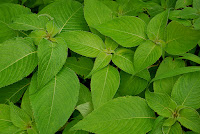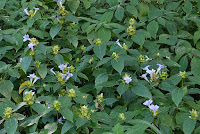<> Celaenorrhinus leucocera (Kollar, [1844]) <>
the Common Spotted Flat ผีเสื้อปีกราบลายจุดธรรมดา
Click on any photo to see all photos full size in Lightbox
Additions and corrections to the information provided on this page is always welcome. Please use the Contact form.
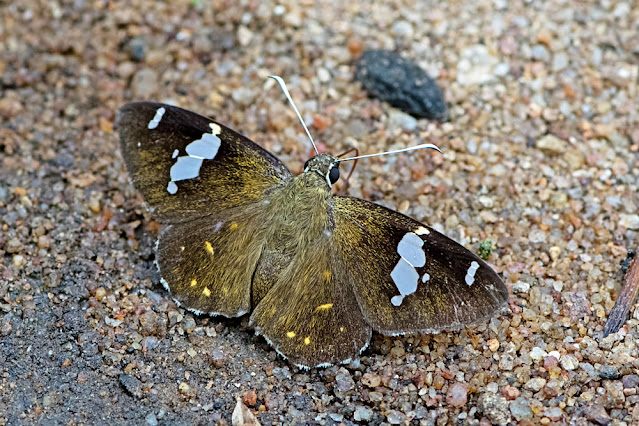
Photo taken at Lamnamkok National Park, Chiang Rai, Thailand ♂ 450m a.s.l.

A common and widespread species across most of the SE Asia region. Sexes are similar in appearance but the female is slightly larger. It is however easy to determine the sex visually in the field as the female antennae have white tips while the male antennae are entirely white. Usually only seen singly and very rarely in pairs of groups. Celaenorrhinus leucocera is very active with an extremely rapid and erratic flight, twisting and turning before eventually settling under the leaves of ferns and other vegetation. They like shade but in hazy weather they often bask on low vegetation or on rocks in the vicinity of rivers.
This species is multivoltine and there are four or five broods each year. The adult female lays her eggs on the top or underside of leaves on the host plant. Once hatched the larva eats its eggshell as its first meal and then constructs a shelter made from folding over a piece of leaf and fastening it with silk. A new shelter is constructed after each molt, and in later instars it uses a pair of leaves to accommodate its larger size. It lives and feeds within these shelters for it's entire life and finally pupates within it as well.
Synonyms and previously used names: Celaenorrhinus vitruvius, Celaenorrhinus maculicornis, Celaenorrhinus munda maculicornis, Celaenorrhinus sumitra, Tagiades arminia, Hesperia leucocera
Taxonomy: Animalia - Arthropoda - Insecta - Lepidoptera - Hesperiidae - Pyrginae - Celaenorrhinus - leucocera
Regional subspecies: none
Regional Distribution: Nepal, Bhutan, India, Bangladesh, Myanmar, Thailand, Laos, Vietnam, China, Malaysia, Indonesia
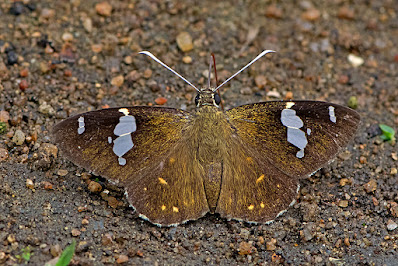 |
Lamnamkok National Park, Chiang Rai, Thailand ♂ 470m a.s.l. |
Habitat: Celaenorrhinus leucocera is found in open areas within evergreen, semi-evergreen, and humid deciduous montane forests. It is also a regular visitor in urban gardens where it visits flowers. It has been recorded at elevations up to 1800m a.s.l.
Flight time: most of the year depending on location Wingspan: 38-42mm
Life History: egg 5-11 days larval stage 28-34 days (full details not known) pupa 9-26 days Total egg to adult <60 days All times are approximate.
Larval Hosts: Asystasia gangetica, Barleria terminalis, Dicliptera sebastinei, Ecbolium ligustrinum, Eranthemum pulchellum, Eranthemum roseum, Lepidagathis cuspidata, Mackaya macrocarpa, Nilgirianthus ciliatus, Ruellia sp., Strobilanthus callosa, Strobilanthes capitata, Strobilanthes ixiocephala, Strobilanthes rosea, Thunbergia grandiflora (Acanthaceae). Actual host plant used depends upon location and availabilty of plant species.
Adult Food Sources: Nectar - Ixora sp., Lantana camara, Stachytarpheta jamaicensis (Verbenaceae), Mussanda sp., Wendlandia coriacea (Rubiaceae), Ageratum conyzoides, Bidens pilosa, Chromolaena odorata (Asteraceae), Cyananthus incanus (Campanulaceae), Rhododendron falconeri (Ericaceae), Dendrobium primulinum (Orchidaceae). Other - mud puddling
 |
| Doi Suthep-Pui National Park, Chiang Mai, Thailand ♀ |
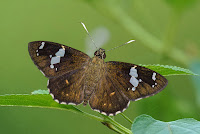 |
| Tat Sae Waterfall area, Luang Prabang, Laos |
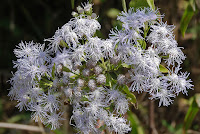 |
| Chromolaena odorata, a nectar source |
 |
| Lamnamkok National Park, Chiang Rai, Thailand ♂ |
 |
| Doi Suthep-Pui National Park, Chiang Mai, Thailand ♀ |
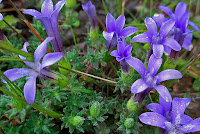 |
| Cyananthus incanus, another nectar source |
Links to other pages in this series for species in the same subfamily

